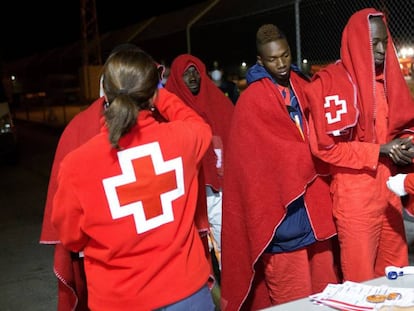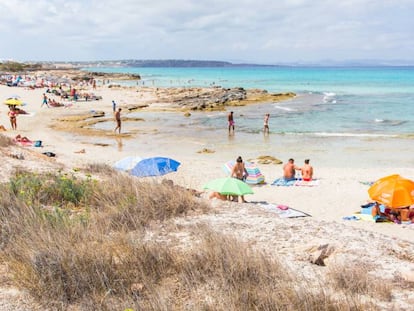The Spanish island aiming to be 100% renewable
El Hierro has just managed to meet power demand for 18 straight days entirely with green energy as Brussels debates the roadmap to meet Paris climate agreement goals


Marco Sánchez confidently bores holes on the sides of a solar panel that will bring electricity to a little house in the hills. Power lines have not yet reached this corner of El Hierro, one of the smallest islands in the Canaries and the furthest one from mainland Spain.
“I started this line of work in 2012,” says Sánchez, 42, after turning off his drill and letting the sounds of nature take over once again. “Since then I’ve been noticing growing interest in renewable energy on the island, either out of necessity or out of environmental concerns.”
Further north, near the capital of an island that barely covers 268 square kilometers, stands the hydro-wind power plant of Gorona del Viento, an innovative project that has turned El Hierro into a clean energy lab.
Five wind turbines, two water deposits, four hydraulic turbines and one pumping station make up a renewable energy experiment that began in 2014. The key to this €82 million project resides in combining the rebellious winds that blow through the island with the docility of still water, and thus solve green energy’s weak point: storage.
“Part of the energy produced by the wind farm goes directly to the clients, and part to pumps that lift water from a lower deposit nearly at sea level to another one at an altitude of 700 meters,” explains Juan Pedro Sánchez, the plant’s boss. When there is no wind, electricity is generated from the water that drops from one deposit to the other.
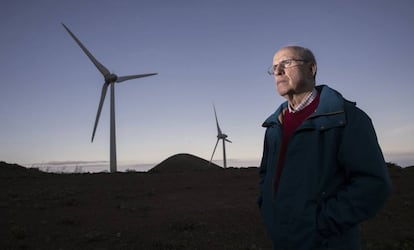
Thanks to this system, last February the island reached a milestone: it managed to meet power demand with 100% renewable energy for 18 consecutive days.
In El Hierro, the landscape changes as quickly as the weather. Valleys of conifers make way for dark cliffs and volcanic reefs, and the heat of the coast quickly fades into the mist surrounding a mountain that reaches 1,500 meters at its highest peak.
These geographical peculiarities determined the design of the hydro-wind complex. A volcano crater was emptied out and turned into the upper water deposit; the hills of Valverde, the island capital where there wind never stops blowing, became the new home for wind generators that can produce 11 megawatts (MW) for a population of just under 11,000 and a power demand of 7 MW at peak times.
The goal is for the plant to generate 100% clean energy year-round. In 2017, it provided 47% of all electricity consumed on the island, 17 points above 2015; the rest is supplied by a diesel plant located next to this one.
“With the last adjustments, we hope to produce in excess of 60% in 2018 and keep going up,” says Sánchez.
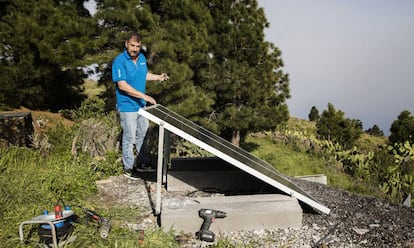
To do that, additional measures will need to be adopted outside the Gorona del Viento plant, explains the head of the island authority (Cabildo insular) of El Hierro, Belén Allende of the Independent El Hierro Group (AHI). The Cabildo has a 60% stake in the plant, with the rest owned by energy company Endesa (30%) and the regional government of the Canary Islands (10%).
Allende notes that El Hierro never opted for “development based on tourism as its single industry” like other nearby islands have done. On the contrary, it placed the emphasis on sustainable growth in order to become self-sufficient on a territory that is far away from the economic and political circuits of the archipelago and the peninsula.
Designated as a Biosphere Reserve in 2000, and a pioneer of organic agriculture and sustainable fishing, El Hierro now wants to put its weight behind electric cars. “We are a laboratory in the making,” says the local politician.
Thanks to Gorona del Viento, El Hierro was able to do without 6,070 tons of diesel fuel in 2017, the equivalent of 40,000 oil barrels. It has also reduced greenhouse gas emissions by 40,000 tons since 2015, making its own small contribution to the fight against climate change.
At the present time, the EU Commission, Council and Parliament (which provided funding for this feature) are negotiating the so-called Winter Package, a list of future directives that will guide the energy transition starting in 2030 in order to meet the Paris climate targets.

Energy from renewable sources, energy savings and empowering consumers are some of the issues on the table in order to achieve a more open and competitive market that will benefit consumers and incentivize new forms of energy generation, in the words of Krišjānis Karinš, a MEP for the Group of the European People’s Party and rapporteur on directives and regulations on common rules for the internal market in electricity.
Pedro Linares, a professor at Pontificia Comillas University, says that “for many years the EU has been a leader in greenhouse gas emission reduction plans. By 2030 there is a commitment to reduce them by 40% from 1990 levels, and between 80% and 95% by 2050.”
In order to achieve this, institutions agree that renewable generation must exceed the 20% target set by the EU for 2020, but there is no consensus on what the new figure should be: the EU Parliament is proposing 35% by 2030, while the Council and the Commission are suggesting a more timid 27%.
“Europe’s global credibility is at stake with this directive,” says the Spanish MEP José Blanco, a contributor to the renewables directive. If requirements are reduced, says Blanco, the 2050 targets will not be reached. Jorge Morales is even stricter. An engineer specialized in renewables, he feels that a 35% target “would mean postponing all efforts to the 2030-2050 period.” Blanco insists on the need to protect self-consumption, to eliminate the so-called “tax on the sun” introduced in Spain, and beefing up legal safety nets for green investments.
“Return on investment in renewables requires a lot of time; if the rules of the game change along the way, it leads to important problems,” says Alberto Ramos, who teaches at the Madrid Polytechnic University.
Claude Turmes, a MEP for the Greens Group / European Free Alliance, explains that retroactive regulatory changes introduced in Spain in 2012 “undermined investment confidence” and slowed down the installation of renewables, making it impossible for the country to meet its 2020 goals. “It is a clear example of what needs to be avoided in the design of energy policies,” he says.
A sign of the times
Tomás Padrón, who headed El Hierro’s island authority for 28 years and an engineer by trade, still gets slightly emotional when he remembers the complicated journey that ended with the creation of the Gorona del Viento power plant. In 1981, he was transferred to the newly created renewables department at Unelco, the electricity utility then operating on the island and since bought up by Endesa.
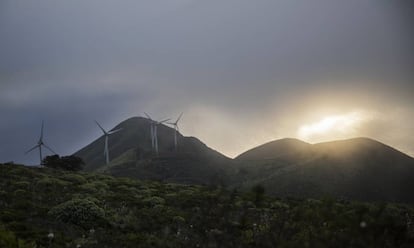
“A group of engineers saw the possibility of installing a wind plant in combination with a water jump (…), and I was excited about the project both as a technician and as a politician.”
Three years after he became head of the Cabildo, the Gorona plan was shelved. In the 1980s, renewables were not high on the international agenda, and a truly peripheral territory like El Hierro, which belongs administratively to the province of Santa Cruz de Tenerife, had neither the influence nor the money to get it started.
It was the beginning of a long pilgrimage through Spanish and European institutions in a bid to secure funding for Gorona. A 2001 meeting with Loyola de Palacio, a Spanish politician who was then the EU Commissioner for Energy and Transport, and a chance encounter in the hallways of Congress with José Luis Rodríguez Zapatero (who was secretary general of the Socialist Party and served as prime minister from 2004 to 2011) changed the course of events.
“I fought so hard to reduce the island’s dependency,” recalls Padrón, sitting in an armchair inside his home in Valverde. Before the plant was up and running, El Hierro was entirely dependent on fossil fuel brought in by oil tankers. When there was a storm, these vessels could not come near the port, leading to blackouts and limiting access to drinking water on an island affected by drought.
Yet not everyone on the island is quite as enthusiastic. Marco Sánchez turns off his drill again and lists the needs that should have been covered before building Gorona del Viento: “Services like telephone lines, broadband internet access, cellphone reception and water treatment are very limited,” he says.
But other islanders like Carlos Álamo feel that the Gorona project is a key element in job creation and economic development. A professional of the hospitality industry, Álamo believes that the plant signals “the beginning of a new era” that has put El Hierro on the international map. The much larger islands of Gran Canaria and Tenerife are planning to build similar plants, and Gorona del Viento gets visits from politicians and researchers from all over the world.
“It is very important to make the difference between a city and an isolated territory in the middle of the Atlantic. It is very difficult for an island to have a renewable penetration of more than 20%,” says Gonzalo Piernavieja, the deputy chief of the Canary Islands’ industry department, and director of R&D at the Canary Islands Technology Institute. “We are world leaders.”
Padrón tells the story of how the early inhabitants of El Hierro used to worship a tree called Garoé. This tree distilled water thanks to the clouds that got trapped in its leaves.
“In the 21st century we have our own technological garoés, the windmills of Gorona,” he says. “We believe that our focus on renewables, considered irrelevant back at the time, has become a reference point (…) that meets an important goal in the fight between fossil and renewable energy. And renewables are going to win the bet.”
English version by Susana Urra.
